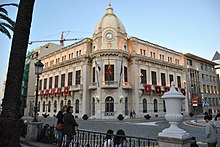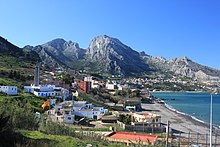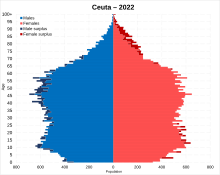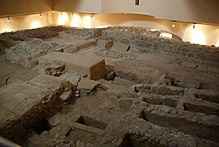Rail Transport In Ceuta
Ceuta, like Melilla and the Canary Islands, was classified as a free port before Spain joined the European Union. Its population is predominantly Christian and Muslim, with a small minority of Sephardic Jews and Sindhi Hindus, from Pakistan.
Spanish is the official language, while Darija Arabic is also a well-spoken language there.
Names
The name Abyla has been said to have been a Punic name ("Lofty Mountain" or "Mountain of God") for Jebel Musa, the southern Pillar of Hercules. The name of the mountain was in fact Habenna (Punic: 𐤀𐤁𐤍, ʾbn, "Stone" or "Stele") or ʾAbin-ḥīq (𐤀𐤁𐤍𐤇𐤒, ʾbnḥq, "Rock of the Bay"), about the nearby Bay of Benzú. The name was hellenized variously as Ápini (Ancient Greek: Ἄπινι), Abýla (Ἀβύλα), Abýlē (Ἀβύλη), Ablýx (Ἀβλύξ), and Abilē Stḗlē (Ἀβίλη Στήλη, "Pillar of Abyla") and in Latin as Abyla Mons ("Mount Abyla") or Abyla Columna ("the Pillar of Abyla").
The settlement below Jebel Musa was later renamed for the seven hills around the site, collectively referred to as the "Seven Brothers" (Ancient Greek: Ἑπτάδελφοι, romanized: Heptádelphoi; Latin: Septem Fratres). In particular, the Roman stronghold at the site took the name "Fort at the Seven Brothers" (Castellum ad Septem Fratres). This was gradually shortened to Septem (Σέπτον Sépton) or, occasionally, Septum or Septa. These clipped forms continued as Berber Sebta and Arabic Sabtan or Sabtah (سبتة), which themselves became Ceuta in Portuguese (pronounced [ˈseu̯tɐ]) and Spanish (locally pronounced [ˈseu̯ta]).
History
Ancient

Controlling access between the Atlantic Ocean and the Mediterranean Sea, the Strait of Gibraltar is an important military and commercial chokepoint. The Phoenicians realized the extremely narrow isthmus joining the Peninsula of Almina to the African mainland made Ceuta eminently defensible and established an outpost there early in the 1st millennium BC. The Greek geographers record it by variations of Abyla, the ancient name of nearby Jebel Musa. Beside Calpe, the other Pillar of Hercules now known as the Rock of Gibraltar, the Phoenicians established Kart at what is now San Roque, Spain. Other good anchorages nearby became Phoenician and then Carthaginian ports at what are now Tangiers and Cádiz.
After Carthage's destruction in the Punic Wars, most of northwest Africa was left to the Roman client states of Numidia and—around Abyla—Mauretania. Punic culture continued to thrive in what the Romans knew as "Septem". After the Battle of Thapsus in 46 BC, Caesar and his heirs began annexing North Africa directly as Roman provinces but, as late as Augustus, most of Septem's Berber residents continued to speak and write in Punic.
Caligula assassinated the Mauretanian king Ptolemy in AD 40 and seized his kingdom, which Claudius organized in AD 42, placing Septem in the province of Tingitana and raising it to the level of a colony. It subsequently was Romanized and thrived into the late 3rd century, trading heavily with Roman Spain and becoming well known for its salted fish. Roads connected it overland with Tingis (Tangiers) and Volubilis. Under Theodosius I in the late 4th century, Septem still had 10,000 inhabitants, nearly all Christian citizens speaking African Romance, a local dialect of Latin.
Medieval
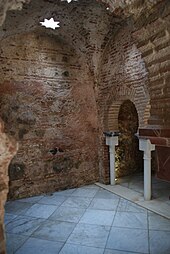

Vandals, probably invited by Count Boniface as protection against the empress dowager, crossed the strait near Tingis around 425 and swiftly overran Roman North Africa. Their king, Gaiseric, focused his attention on the rich lands around Carthage; although the Romans eventually accepted his conquests and he continued to raid them anyway, he soon lost control of Tingis and Septem in a series of Berber revolts. When Justinian decided to reconquer the Vandal lands, his victorious general Belisarius continued along the coast, making Septem a westernmost outpost of the Byzantine Empire around 533. Unlike the former ancient Roman administration, however, Eastern Rome did not push far into the hinterland and made the more defensible Septem their regional capital in place of Tingis.
Epidemics, less capable successors and overstretched supply lines forced a retrenchment and left Septem isolated. It is likely that its count (comes) was obliged to pay homage to the Visigoth Kingdom in Spain in the early 7th century. There are no reliable contemporary accounts of the end of the Islamic conquest of the Maghreb around 710. Instead, the rapid Muslim conquest of Spain produced romances concerning Count Julian of Septem and his betrayal of Christendom in revenge for the dishonor that befell his daughter at King Roderick's court. Allegedly with Julian's encouragement and instructions, the Berber convert and freedman Tariq ibn Ziyad took his garrison from Tangiers across the strait and overran the Spanish so swiftly that both he and his master Musa bin Nusayr fell afoul of a jealous caliph, who stripped them of their wealth and titles.
After the death of Julian, sometimes also described as a king of the Ghomara Berbers, Berber converts to Islam took direct control of what they called Sebta. It was then destroyed during their great revolt against the Umayyad Caliphate around 740. Sebta subsequently remained a small village of Muslims and Christians surrounded by ruins until its resettlement in the 9th century by Mâjakas, chief of the Majkasa Berber tribe, who started the short-lived Banu Isam dynasty. His great-grandson briefly allied his tribe with the Idrisids, but Banu Isam rule ended in 931 when he abdicated in favor of Abd ar-Rahman III, the Umayyad ruler of Córdoba, Spain.
Chaos ensued with the fall of the Caliphate of Córdoba in 1031. Following this, Ceuta and Muslim Iberia were controlled by successive North African dynasties. Starting in 1084, the Almoravid Berbers ruled the region until 1147, when the Almohads conquered the land. Apart from Ibn Hud's rebellion in 1232, they ruled until the Tunisian Hafsids established control. The Hafsids' influence in the west rapidly waned, and Ceuta's inhabitants eventually expelled them in 1249. After this, a period of political instability persisted, under competing interests from the Marinids and Granada as well as autonomous rule under the native Banu al-Azafi. The Fez finally conquered the region in 1387, with assistance from Aragon.
Portuguese



On the morning of 21 August 1415, King John I of Portugal led his sons and their assembled forces in a surprise assault that would come to be known as the Conquest of Ceuta. The battle was almost anticlimactic, because the 45,000 men who traveled on 200 Portuguese ships caught the defenders of Ceuta off guard and suffered only eight casualties. By nightfall the town was captured. On the morning of 22 August, Ceuta was in Portuguese hands. Álvaro Vaz de Almada, 1st Count of Avranches was asked to hoist what was to become the flag of Ceuta, which is identical to the flag of Lisbon, but in which the coat of arms derived from that of the Kingdom of Portugal was added to the center; the original Portuguese flag and coat of arms of Ceuta remained unchanged, and the modern-day Ceuta flag features the configuration of the Portuguese shield.
John's son Henry the Navigator distinguished himself in the battle, being wounded during the conquest. The looting of the city proved to be less profitable than expected for John I, so he decided to keep the city to pursue further enterprises in the area.
From 1415 to 1437, Pedro de Meneses became the first governor of Ceuta.
The Marinid Sultanate started the 1419 siege but was defeated by the first governor of Ceuta before reinforcements arrived in the form of John, Constable of Portugal and his brother Henry the Navigator, who were sent with troops to defend Ceuta.
Under King John I's son, Duarte, the colony at Ceuta rapidly became a drain on the Portuguese treasury. Trans-Saharan trade journeyed instead to Tangier. It was soon realized that without the city of Tangier, possession of Ceuta was worthless. In 1437, Duarte's brothers Henry the Navigator and Fernando, the Saint Prince persuaded him to launch an attack on the Marinid sultanate. The resulting Battle of Tangier (1437), led by Henry, was a debacle. In the resulting treaty, Henry promised to deliver Ceuta back to the Marinids in return for allowing the Portuguese army to depart unmolested, which he reneged on.
Possession of Ceuta indirectly led to further Portuguese expansion. The main area of Portuguese expansion, at this time, was the coast of the Maghreb, where there was grain, cattle, sugar, and textiles, as well as fish, hides, wax, and honey.
Ceuta had to endure alone for 43 years, until the position of the city was consolidated with the taking of Ksar es-Seghir (1458), Arzila and Tangier (1471) by the Portuguese.
The city was recognized as a Portuguese possession by the Treaty of Alcáçovas (1479) and by the Treaty of Tordesillas (1494).
In the 1540s the Portuguese began building the Royal Walls of Ceuta as they are today including bastions, a navigable moat and a drawbridge. Some of these bastions are still standing, like the bastions of Coraza Alta, Bandera and Mallorquines.
Luís de Camões lived in Ceuta between 1549 and 1551, losing his right eye in battle, which influenced his work of poetry Os Lusíadas.
Union between Portugal and Spain
In 1578 King Sebastian of Portugal died at the Battle of Alcácer Quibir (known as the Battle of Three Kings) in what is today northern Morocco, without descendants, triggering the 1580 Portuguese succession crisis. His grand-uncle, the elderly Cardinal Henry, succeeded him as King, but also had no descendants, having taken holy orders. When the cardinal-king died after two years later, three grandchildren of King Manuel I of Portugal claimed the throne:
- Infanta Catarina, Duchess of Braganza
- António, Prior of Crato
- Philip II of Spain, uncle of former King Sebastian of Portugal
Philip prevailed and was crowned King Philip I of Portugal in 1581, uniting the two crowns and overseas empires.
During the Union with Spain, 1580 to 1640, Ceuta attracted many settlers of Spanish origin and became the only city of the Portuguese Empire that sided with Spain when Portugal regained its independence in the Portuguese Restoration War of 1640.
Spanish




On 1 January 1668, King Afonso VI of Portugal recognised the formal allegiance of Ceuta to Spain and ceded Ceuta to King Carlos II of Spain by the Treaty of Lisbon.
The city was attacked by Moroccan forces under Moulay Ismail during the Siege of Ceuta (1694–1727). During the longest siege in history, the city underwent changes leading to the loss of its Portuguese character. While most of the military operations took place around the Royal Walls of Ceuta, there were also small-scale penetrations by Spanish forces at various points on the Moroccan coast, and seizure of shipping in the Strait of Gibraltar.
During the Napoleonic Wars (1803–1815), Spain allowed Britain to occupy Ceuta. Occupation began in 1810, with Ceuta being returned at the conclusion of the wars. Disagreements regarding the border of Ceuta resulted in the Hispano-Moroccan War (1859–60), which ended at the Battle of Tetuán.
In July 1936, General Francisco Franco took command of the Spanish Army of Africa and rebelled against the Spanish republican government; his military uprising led to the Spanish Civil War of 1936–1939. Franco transported troops to mainland Spain in an airlift using transport aircraft supplied by Germany and Italy. Ceuta became one of the first battlegrounds of the uprising: General Franco's rebel nationalist forces seized Ceuta, while at the same time the city came under fire from the air and sea forces of the official republican government.
The Llano Amarillo monument was erected to honor Francisco Franco; it was inaugurated on 13 July 1940. The tall obelisk has since been abandoned, but the shield symbols of the Falange and Imperial Eagle remain visible.
Following the 1947 Partition of India, a substantial number of Sindhi Hindus from current-day Pakistan settled in Ceuta, adding to a small Hindu community that had existed in Ceuta since 1893, connected to Gibraltar's.
When Spain recognized the independence of Spanish Morocco in 1956, Ceuta and the other plazas de soberanía remained under Spanish rule. Spain considered them integral parts of the Spanish state, but Morocco has disputed this point.
Culturally, modern Ceuta is part of the Spanish region of Andalusia. It was attached to the province of Cádiz until 1995, the Spanish coast being only 20 km (12.5 miles) away. It is a cosmopolitan city, with a large ethnic Arab-Berber Muslim minority as well as Sephardic Jewish and Hindu minorities.
On 5 November 2007, King Juan Carlos I visited the city, sparking great enthusiasm from the local population and protests from the Moroccan government. It was the first time a Spanish head of state had visited Ceuta in 80 years.
Since 2010, Ceuta (and Melilla) have declared the Muslim holiday of Eid al-Adha, or Feast of the Sacrifice, an official public holiday. It is the first time a non-Christian religious festival has been officially celebrated in Spanish ruled territory since the Reconquista.
